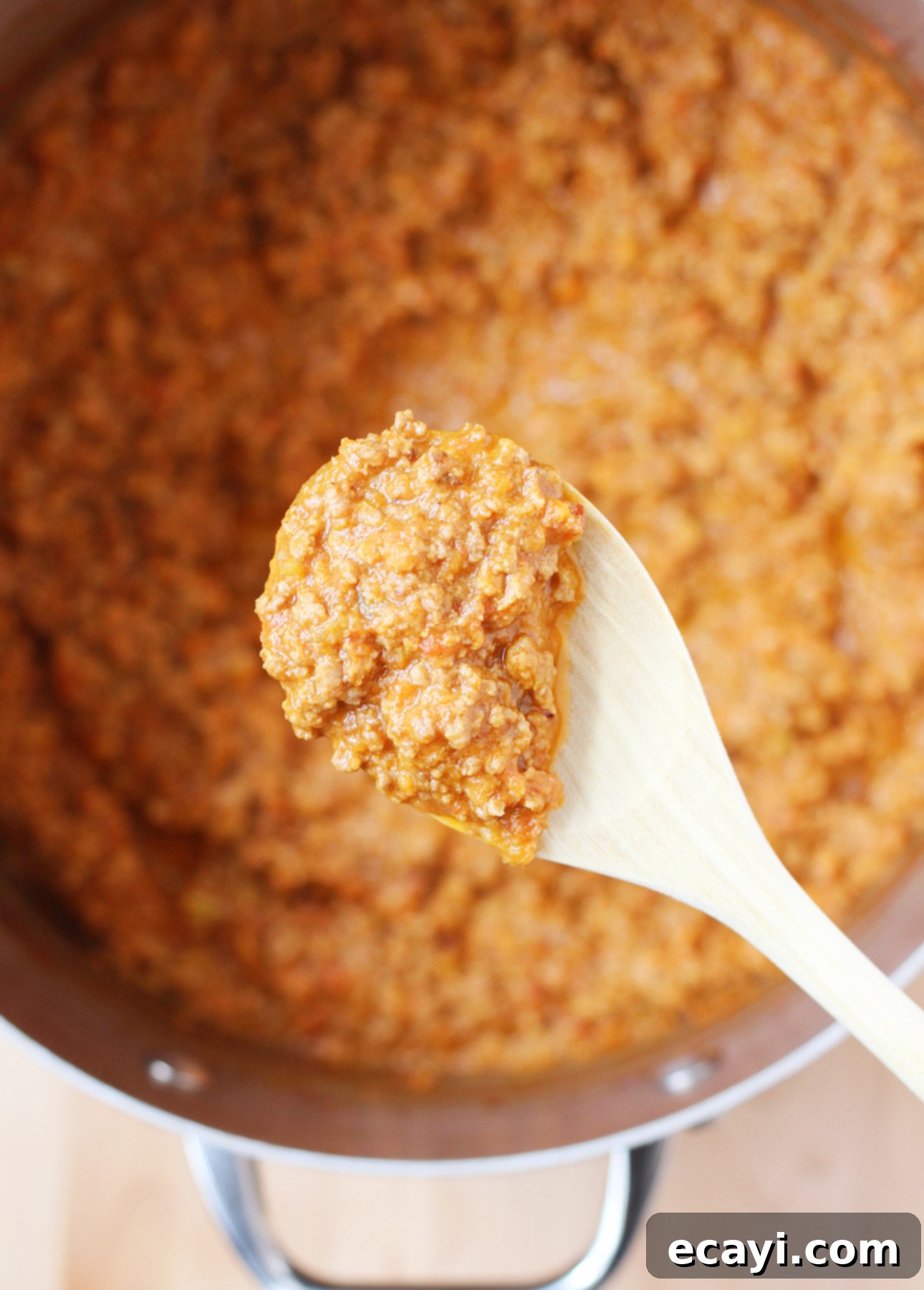Authentic Italian Bolognese Sauce (Ragù Bolognese) Recipe: The Ultimate Guide
Embark on a culinary journey to Emilia-Romagna with this authentic Bolognese Sauce recipe, officially based on the registered Italian tradition for Ragù Bolognese. Far from the common North American interpretation, this is a truly meat-centric, rich, creamy, and exquisitely aromatic pasta sauce. Discover the secrets to making and serving the finest version of this Italian culinary masterpiece, guaranteed to transform your pasta dishes!
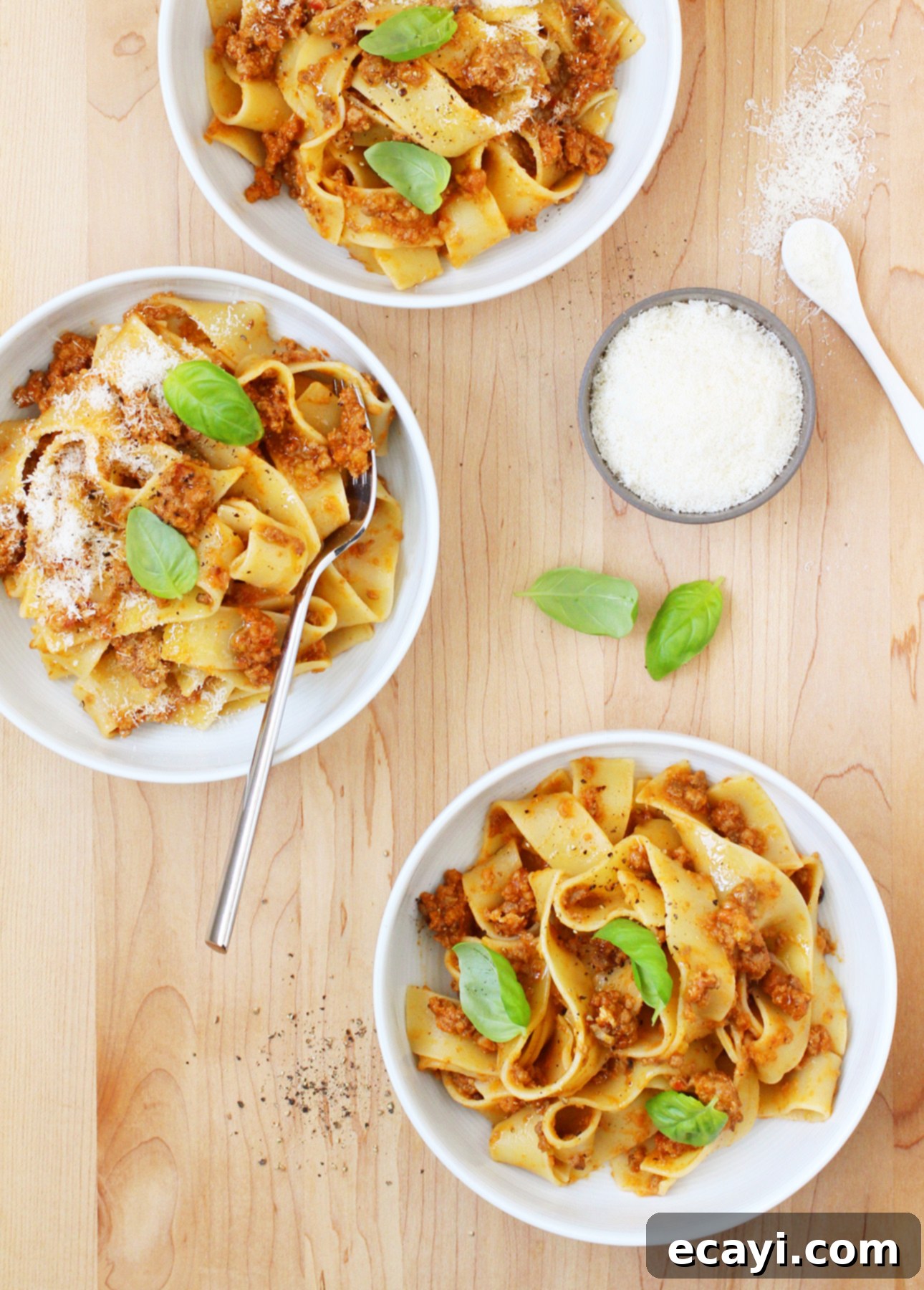
This post contains affiliate links. Full disclosure is at the bottom of the article.
For many years, “Bolognese sauce” in North America has been a broad term for almost any ground meat and tomato-based pasta topping. However, experiencing true Bolognese in Italy is an entirely different revelation. My first unforgettable encounter with authentic Bolognese, known as Ragù Bolognese in its homeland, took place in the charming university town of Modena. Wandering through its inviting streets, I stumbled upon a modern café – a stylish spot with pristine white decor, relaxing lounge music, and comfortable couches where students mingled or studied. The friendly owner, upon learning we had just arrived in the region, enthusiastically recommended his Pappardelle Bolognese. He spoke with immense pride about his daily slow-simmered sauce, meticulously prepared with only the freshest, high-quality ingredients. His eagerness for us to taste our very first authentic Bolognese was palpable, and the experience certainly lived up to the hype.
The sauce was robustly meaty yet surprisingly delicate in flavor, incredibly aromatic, and wonderfully creamy. It was unlike any pasta dish I had ever tasted, achieving a perfect harmony that was further elevated by a generous sprinkle of freshly grated Parmigiano-Reggiano. This dish showcased a depth of flavor and texture that was both comforting and sophisticated, a testament to its slow cooking and careful preparation. It instantly redefined my understanding of what Bolognese truly is.
My inaugural taste of Ragù Bolognese occurred in Modena, Italy, back in 2007. This blurry photograph serves as a cherished memento of that transformative culinary moment!
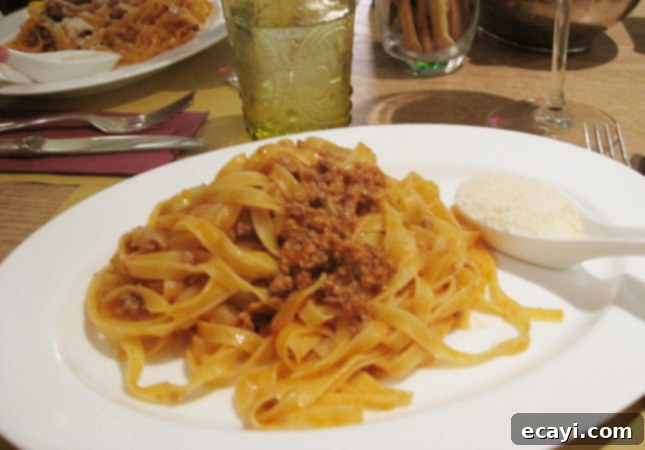
Throughout the rest of my trip, I indulged in several more servings of this magnificent yet deceptively simple dish, deepening my appreciation for its nuanced flavors. Returning home, I was determined to recreate the sublime Bolognese Sauce I had enjoyed in Italy, or Ragù Bolognese, as it is correctly termed in its country of origin. This quest led me to extensive research and countless kitchen experiments.
It quickly became apparent that Italians approach their culinary heritage with profound seriousness, especially when it comes to a classic like Bolognese. To safeguard its authenticity, the Academia Italiana della Cucina (Italian Academy of Cuisine) formally registered the recipe with the Bologna Chamber of Commerce in 1982. This official registration specifies the core ingredients that define an authentic Bolognese sauce: onions, celery, carrots (forming the crucial soffritto), pancetta, ground beef, tomatoes, milk, and white wine. This dedication to preserving traditional recipes highlights the cultural significance of Ragù Bolognese.
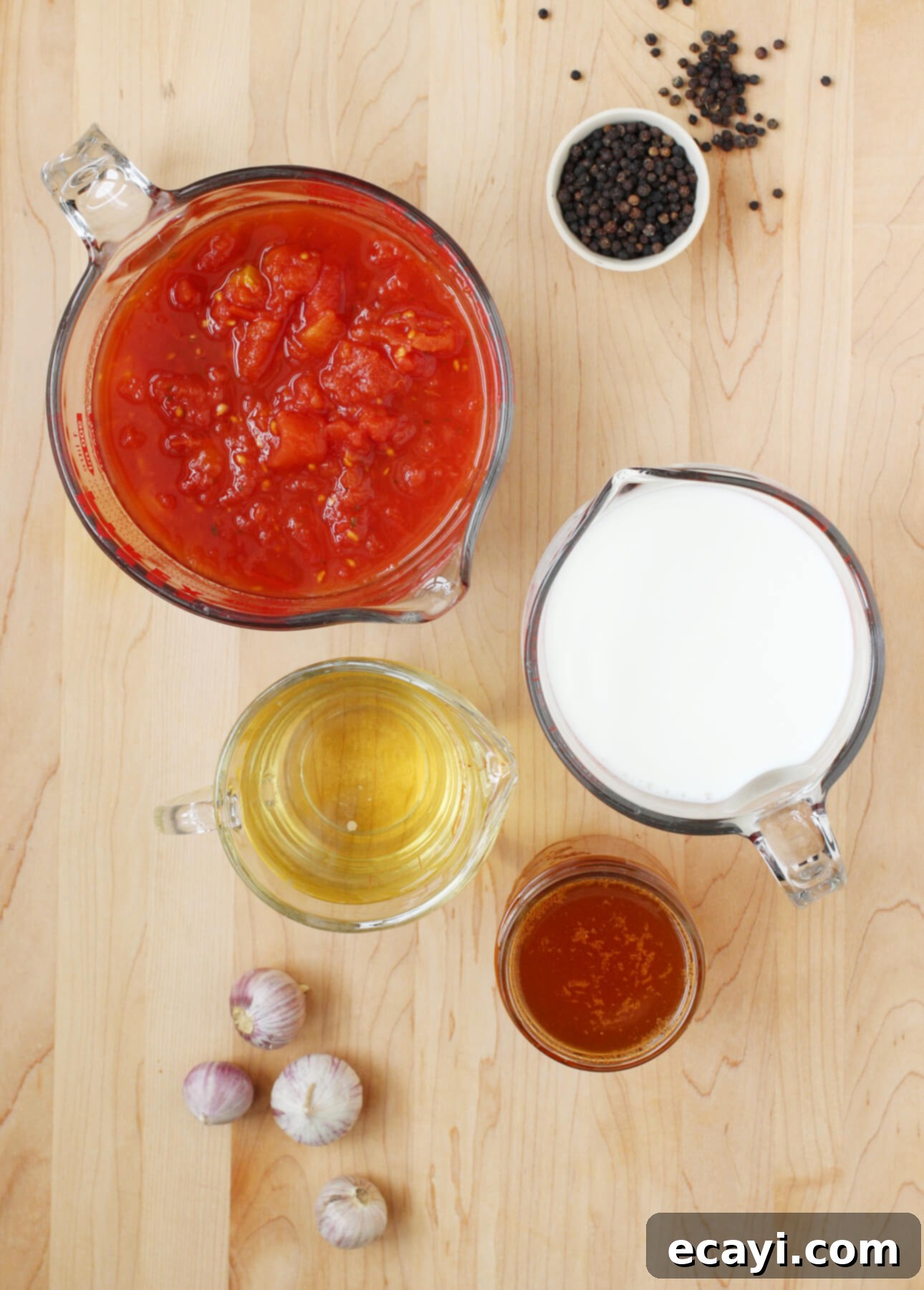
While the registered recipe provides a definitive foundation, it’s important to note that there isn’t a single, immutable recipe for Italian Bolognese sauce. Regional and familial variations exist, with ingredient ratios often differing. However, the fundamental components remain constant. After extensive research, comparison with numerous traditional Italian cookbooks, and rigorous testing in my own kitchen, I developed a recipe that I believe comes remarkably close to the exquisite sauce I savored in and around Bologna. This recipe embodies the authentic spirit and rich flavor profile of true Ragù Bolognese.
I sincerely hope that you and your loved ones will cherish this Italian Bolognese sauce as much as my family does. It has become an enduring classic in my home, a constant source of comfort and joy. In fact, it has been my son’s absolute favorite dish since he was first able to hold a spoon. If this recipe captures your heart and taste buds, please share your experience in the comment section below. I always find immense pleasure in hearing from my readers!
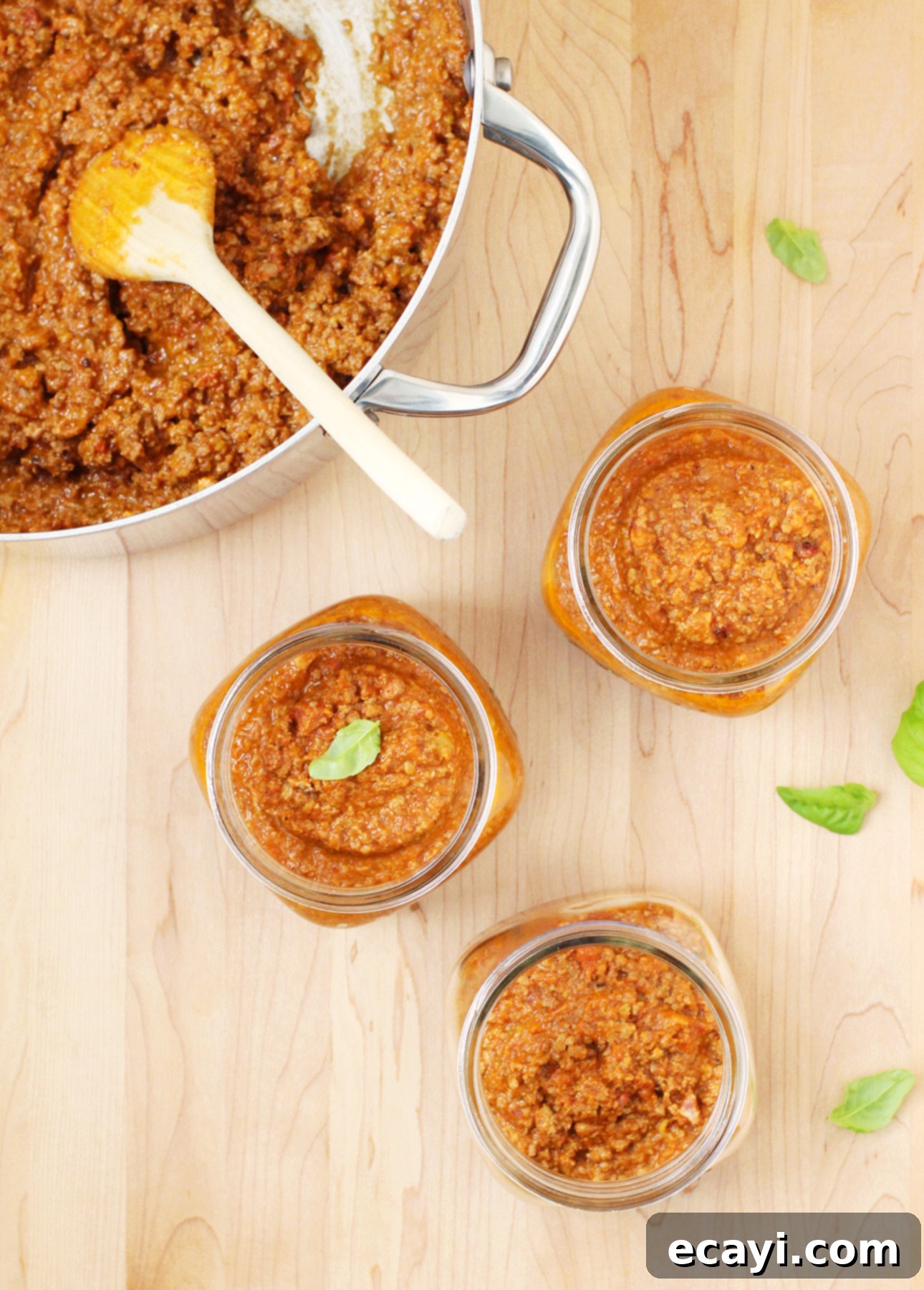
VIDEO: Master the Art of Authentic Bolognese Sauce
Unlock the secrets to crafting the BEST authentic Bolognese sauce by watching this comprehensive video. You’ll learn critical steps such as properly dicing vegetables for the perfect soffritto and expertly caramelizing the meat to develop deep flavors. Furthermore, the video demonstrates the optimal way to serve this classic Italian sauce, ensuring you impress both your family and your guests with a truly traditional and delicious meal!
Printable Bolognese Recipe Card
This comprehensive article meticulously details the recipe steps, complete with helpful pictures to guide you through each stage. However, if you’re eager to get cooking immediately, you can effortlessly jump straight to a printable version of the recipe card located at the bottom of this post.
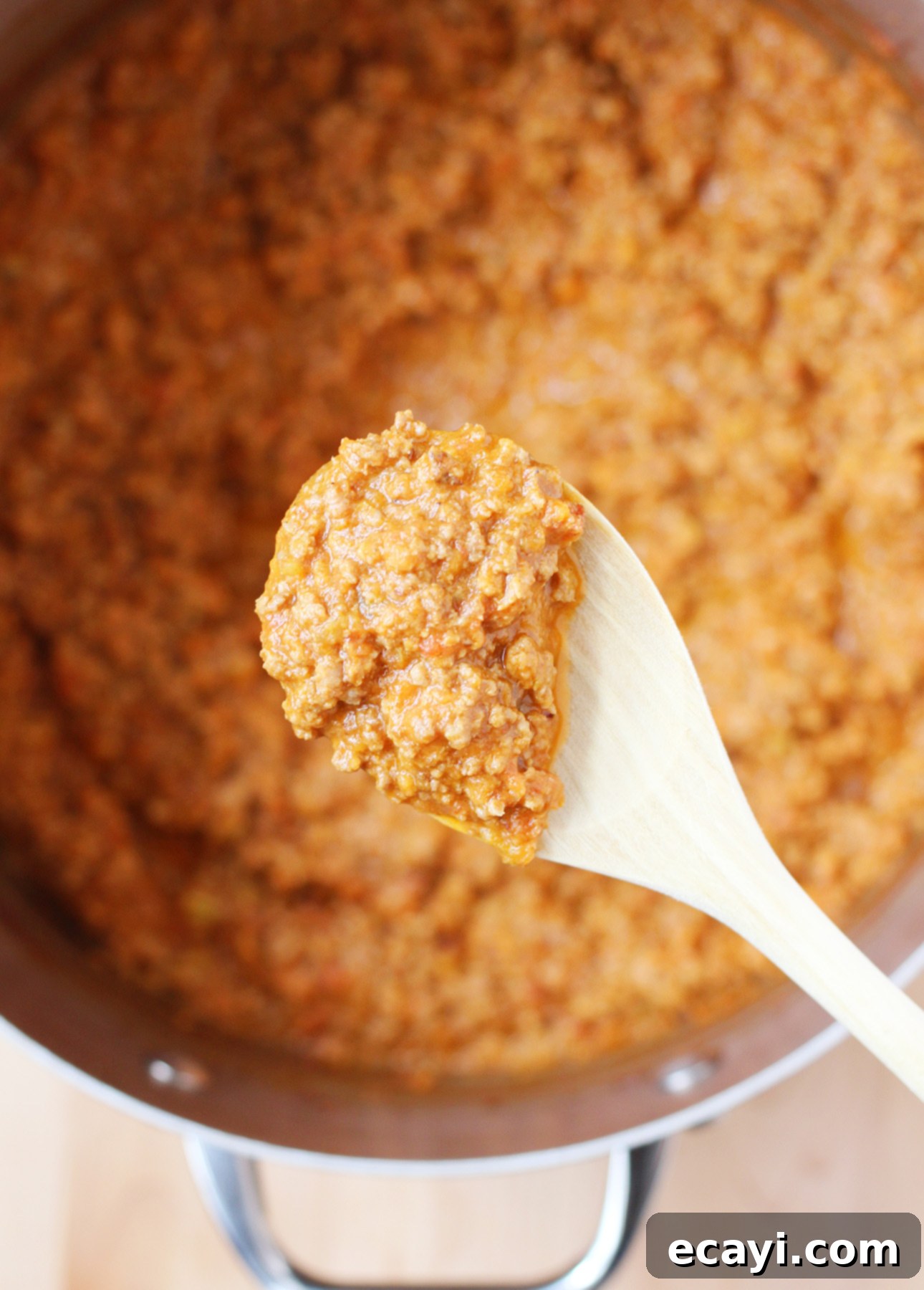
Key Ingredients for an Authentic Bolognese Sauce
Crafting an authentic Ragù Bolognese relies on understanding the purpose and quality of each ingredient. Here’s a closer look at what makes this sauce truly special:
Onion, Celery, Carrots – The Foundation of Flavor (Soffritto)
The triumvirate of finely diced onion, celery, and carrots, gently cooked in olive oil and seasoned with salt and pepper, is known in Italian cuisine as a soffritto. This aromatic base is the cornerstone of countless Italian dishes, including Bolognese sauce. This initial step demands the most precision and knife skills; you must dice everything uniformly into small ¼-inch (0.5-cm) pieces. Dedicate a few extra minutes to achieve this uniformity, as it ensures the vegetables cook evenly, release their full spectrum of flavors, and contribute a delightful, consistent texture to the final sauce.
A Note on Garlic: The inclusion of garlic in classic Bolognese sauce is a subject of fervent debate among traditionalists. While many authentic recipes omit it, some purists consider its addition to be culinary blasphemy. Personally, I find that a small amount of minced garlic introduces an additional layer of aromatic complexity that I truly enjoy. Ultimately, whether to include garlic is a matter of personal preference and taste. Feel free to experiment and decide for yourself!
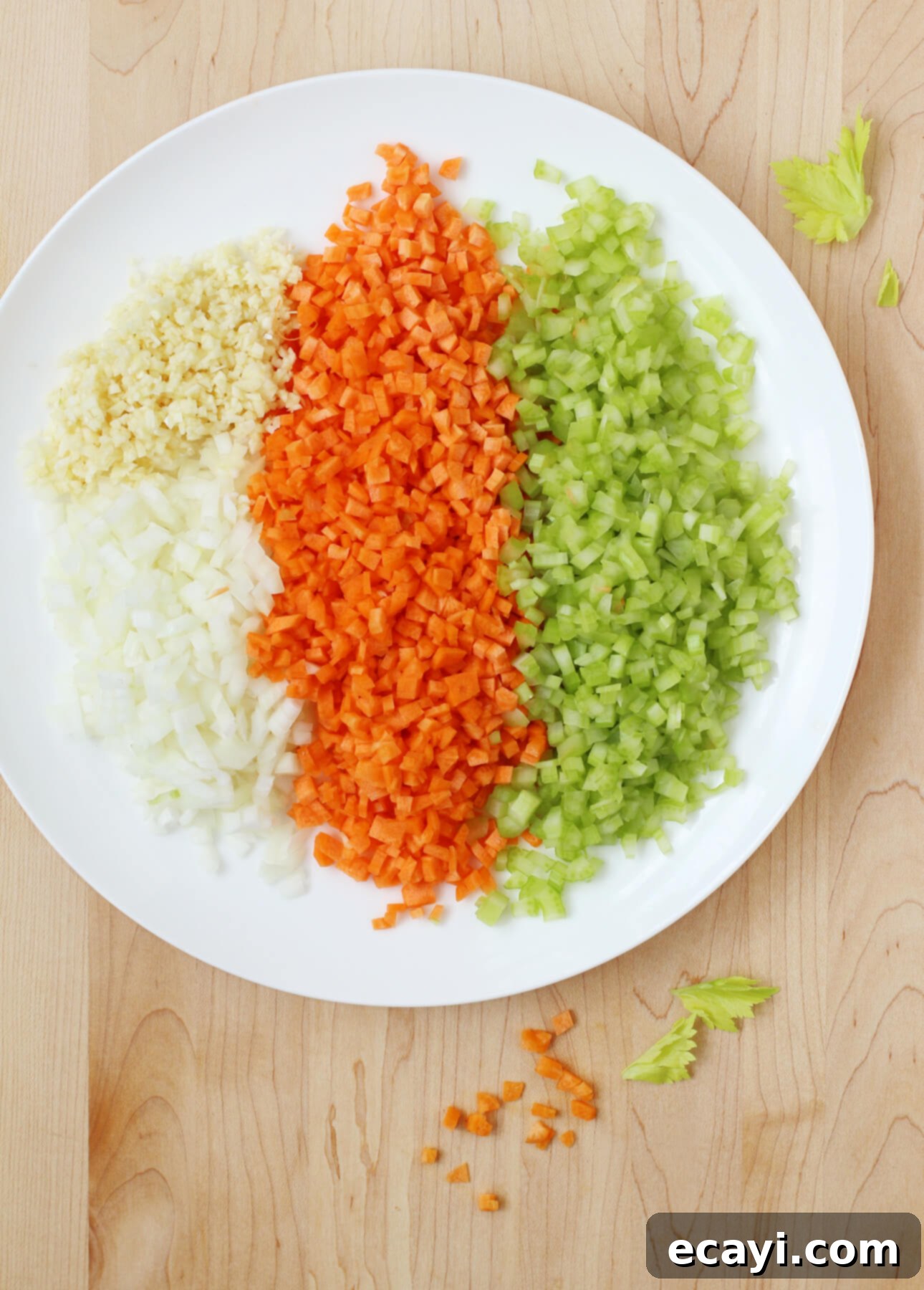
Tomatoes
It might surprise you to learn that tomatoes are not the predominant ingredient in Italian Bolognese sauce. Unlike the bright red, tomato-heavy sauces many of us grew up with in North America, authentic Italian Bolognese is first and foremost a meat-centric, rich, and creamy sauce. Tomatoes are included for their subtle flavor contribution and acidity balance, but only in a relatively small quantity compared to the overall volume of meat. For optimal texture and integration, I prefer using diced tomatoes, specifically petite diced tomatoes, as they blend seamlessly with the other ingredients. Alternatively, crushed tomatoes can be used for a smoother consistency. While premium San Marzano tomatoes are excellent, they are not strictly necessary for this recipe. If you have whole canned tomatoes, simply puree them using a hand mixer, blender, or food processor.
Ground Meat
For the best results, opt for lean ground meat. My preferred combination is a 50/50 blend of ground beef and ground veal, which offers a perfect balance of flavor and tenderness. However, you can certainly use either beef or veal exclusively, or any combination thereof, depending on your preference and availability.
Pancetta
Diced pancetta is an indispensable ingredient for this recipe. While thinly sliced pancetta is commonly found in grocery stores, it won’t provide the desired texture and richness for Bolognese. You’re looking for small, cubed pieces that render fat and add both incredible flavor and a slight chewiness. Some brands offer pre-diced pancetta; if you can’t find it, ask your butcher or a specialty deli to cut it for you. The savory, slightly sweet, and salty notes of good quality pancetta are absolutely worth seeking out.
Milk
The inclusion of milk often surprises those unfamiliar with authentic Bolognese. Most people don’t typically add milk to meat sauces, yet in this recipe, it’s the miraculous secret ingredient that imparts an unparalleled richness and creamy body to the sauce. It also plays a crucial role in tenderizing the meat, resulting in a sauce that is more orange-hued than vibrant red. Use whole milk (3.25% m.f.) or partly skimmed milk (2% m.f.). Both regular and lactose-free dairy milk will work. While I haven’t tested vegan milks (soy, rice, nut), if you choose to use one, select a variety known to withstand extended boiling without curdling, as many plant-based alternatives can separate and affect the sauce’s texture and appearance. Do not substitute with cream, as it will make the sauce too heavy and rich.
Broth
The original 1982 Academia Italiana della Cucina recipe does not explicitly list broth, but many traditional recipes add water to facilitate the long simmering process and prevent the sauce from drying out. I’ve found that using beef stock instead of water significantly enhances the depth and complexity of the sauce. Vegetable broth or plain water can be used as alternatives if preferred.
Seasonings
Perhaps surprisingly, this authentic Bolognese recipe relies on a very minimalistic approach to seasonings, deliberately omitting aromatic herbs or exotic spices. It is generally frowned upon in traditional Italian cuisine to add bay leaves or red pepper flakes to Bolognese sauce. The primary flavor enhancers in this recipe are simply sea salt and freshly ground black pepper. For superior flavor and subtle seasoning, I highly recommend using fine sea salt or kosher salt over regular table salt.
Pasta
Given its hearty and substantial nature, Bolognese sauce demands a pasta shape that can truly stand up to its weight and rich texture. In Italy, it is most frequently served with wide, flat pastas like pappardelle—the extra-wide variety I’ve used in the accompanying images is particularly excellent. Other suitable choices include tagliatelle, linguine, or even spaghetti. The golden rule for serving: *always* combine the hot sauce directly with the hot, freshly cooked pasta in a skillet *before* portioning into bowls. This crucial step allows the pasta to absorb the rich flavors of the sauce and become beautifully coated, leading to a far more cohesive and delicious dining experience. For a visual guide, watch my Bolognese recipe video to see precisely how to serve this magnificent sauce to impress everyone at your table!
Cheese
For an authentic and unparalleled flavor experience, insist on using only freshly grated Parmigiano-Reggiano. The distinct sharp, salty, and nutty flavor of this Italian cheese is irreplaceable and forms a perfect culinary marriage with the rich, meaty sauce. This ideal pairing is hardly surprising, considering that both Bolognese sauce and Parmigiano-Reggiano hail from the same esteemed Italian region: Emilia-Romagna.
Stovetop Cooking Method for Authentic Bolognese Sauce
Patience is paramount for this sauce; it simply doesn’t tolerate being rushed. The only way to achieve its characteristic richness in texture and profound depth of flavor is through a slow, extended simmering process—I’m referring to a dedicated two- to three-hour simmer. Initially, you’ll invest about 20 minutes of active cooking time to prepare the soffritto and thoroughly brown the meat. After these foundational steps, the rest of the cooking is largely hands-off, requiring only a quick stir every half hour or so to prevent sticking and ensure even cooking. If your goal is to create a truly authentic Italian Bolognese sauce, committing to this proper, unhurried method is absolutely essential for a superior result.
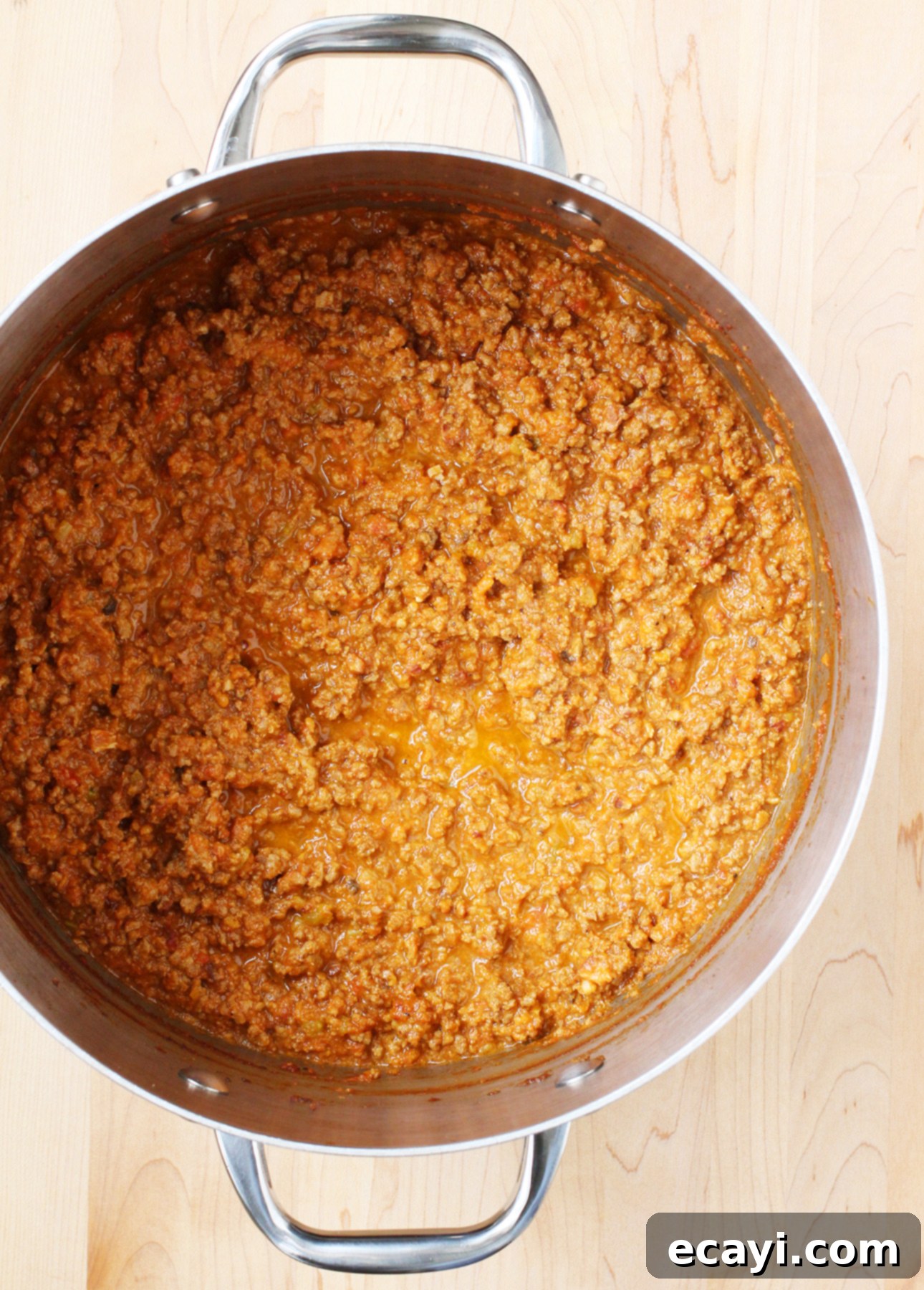
Slow Cooker Method for Bolognese Sauce
Given the frequent inquiries over the years about adapting this beloved sauce for the slow cooker, I dedicated time to meticulously test and develop a reliable method. I’m pleased to announce that my recipe now includes comprehensive slow cooker instructions, which you’ll find conveniently located in the printable recipe card at the bottom of this post.
When preparing Bolognese sauce in a slow cooker, it’s crucial to adjust the quantities of certain liquids to account for the reduced evaporation that occurs in this cooking method:
- 1 cup (250 ml) whole (3.25%) or partly skimmed (2%) milk
- 1 can (14 oz/398 g) diced tomatoes, or crushed tomatoes
- 1/2 cup (125 ml) beef broth
Additionally, you will need to incorporate the following ingredient to achieve the desired body and thickness: 1/4 cup (60 ml) tomato paste. This concentrated paste is essential in the slow cooker method because the sauce won’t benefit from the same level of simmering and natural thickening as it would on the stovetop.
All other ingredients listed for the stovetop method remain unchanged.
To begin the slow cooker process, follow the initial stovetop instructions: cook the onion, carrot, celery, garlic, pancetta, and ground meat until properly browned and tender. Deglaze the pan with white wine as directed, then transfer this flavorful mixture to the bowl of your slow cooker. Stir in the adjusted quantities of milk, tomatoes, beef broth, the added tomato paste, and a generous amount of freshly ground black pepper. (Refrain from adding more salt at this stage; it’s best to taste and adjust the seasoning towards the end of the cooking process.) Cover the slow cooker and cook on the LOW setting for approximately 6 hours. If, after this period, the sauce still appears too soupy or runny, continue cooking for an additional 2 hours. Alternatively, remove the lid and allow it to simmer, uncovered, for about 30 minutes, or until it reaches your desired thick and rich consistency. Conversely, should the sauce seem a bit dry, you can gradually stir in a small amount of extra beef broth to achieve the perfect texture. Always taste the finished sauce and adjust seasonings as needed for optimal flavor.
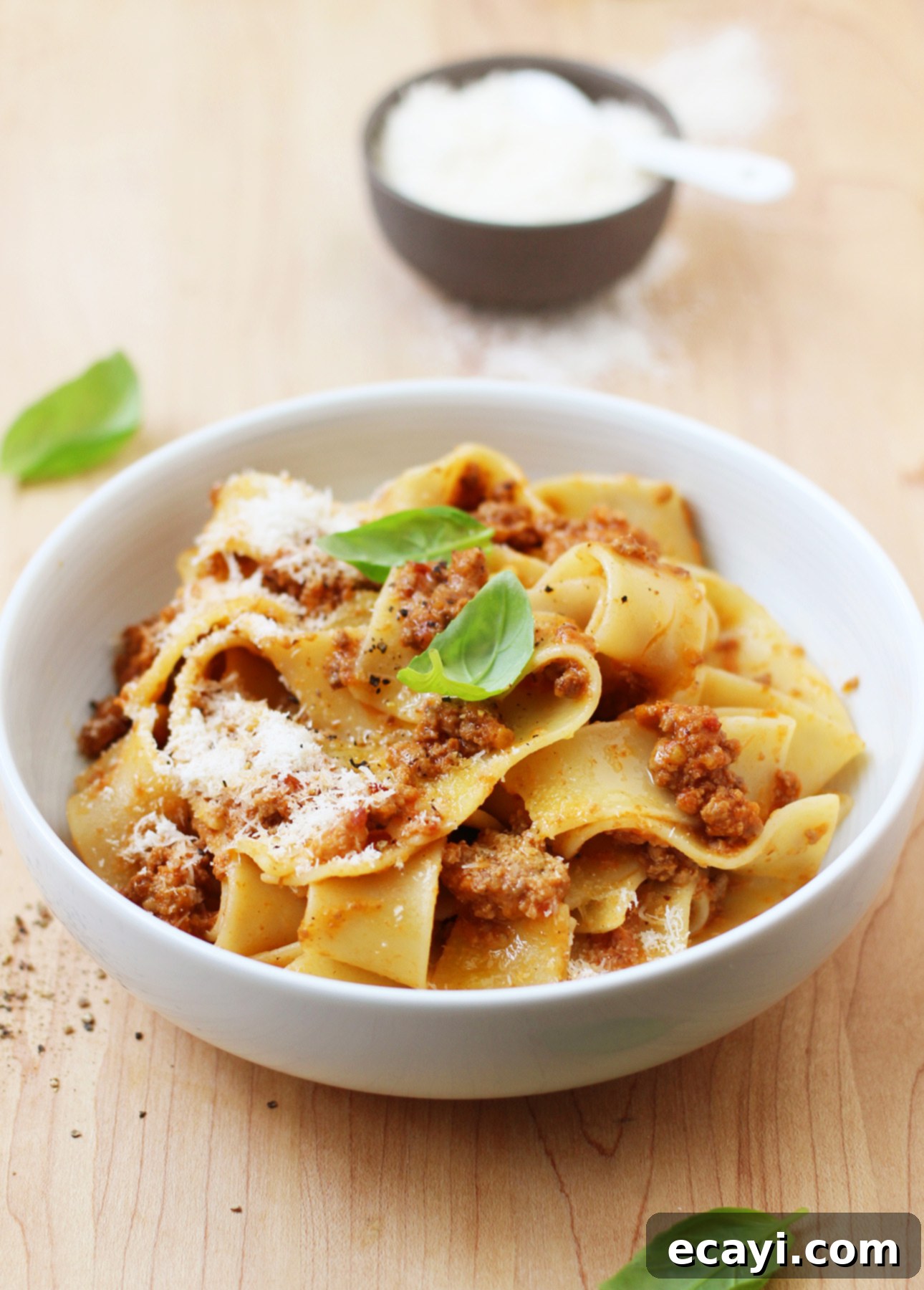
STEP-BY-STEP Recipe for Ragù Bolognese: Authentic Italian Bolognese Sauce
This recipe yields approximately 16 servings of rich, authentic Bolognese sauce.
PRINTABLE VERSION
NEW: WATCH MY BOLOGNESE RECIPE VIDEO
INGREDIENTS
- 2 tbsp (30 ml) extra-virgin olive oil
- 1/4 cup (60 ml) butter
- 1 medium-sized yellow onion, diced
- 4 small, or 2 large, carrots, peeled and diced
- 2 celery stalks, diced
- 4 garlic cloves, minced (optional, see notes above)
- 1 cup (250 ml) diced pancetta (approximately 4.5 oz/125 g)
- 1 tsp (5 ml) kosher salt, or fine sea salt
- Freshly ground black pepper
- 2 lb (1 kg) lean ground meat (beef, veal, or a combination)
- 1 cup (250 ml) dry white wine (such as Chardonnay or Pinot Grigio)
- 2 cups (500 ml) whole (3.25% m.f.) or partly skimmed (2%) milk
- 1 can (28 oz/794 g) diced tomatoes, or crushed tomatoes
- 1 cup (250 ml) beef stock (or vegetable broth/water)
To Serve
- Freshly grated Parmigiano-Reggiano
- Dried pappardelle, tagliatelle, linguine, or spaghetti
- Fresh basil (optional garnish)
METHOD
1. In a large, heavy-bottomed stockpot or Dutch oven set over medium heat, add the butter and olive oil. Stir until the butter is completely melted and combined with the oil. Add the diced onion, carrot, celery, and minced garlic (if using), along with half of the salt (½ tsp/2 ml). Sauté these vegetables for about 5 minutes, stirring frequently, until they have softened and become aromatic, forming your foundational soffritto.
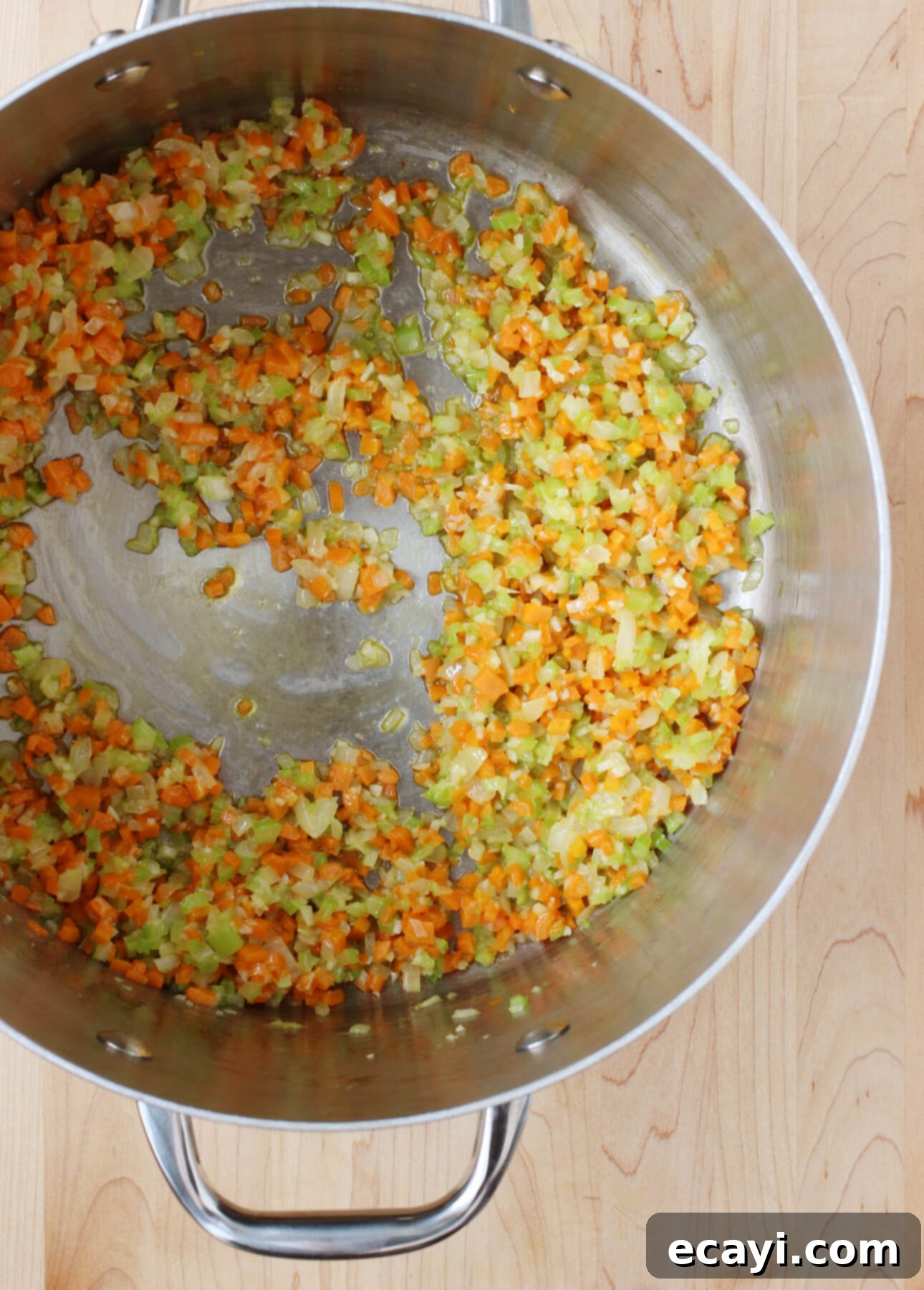
2. Add the diced pancetta to the pot with the softened vegetables. Continue to cook for another 10 minutes, stirring occasionally, until the pancetta turns beautifully golden brown and becomes crisp, rendering its flavorful fat into the mixture.
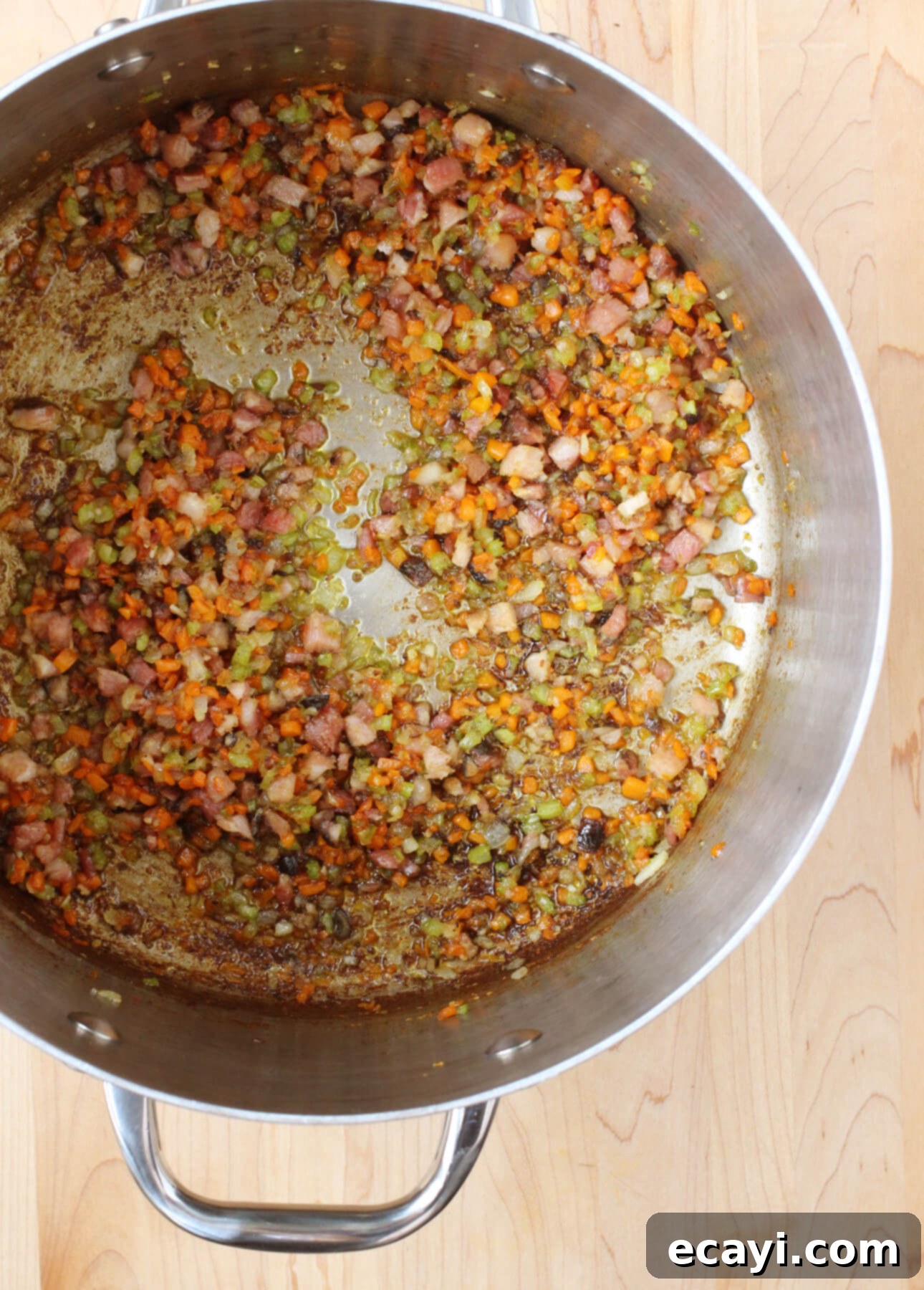
3. Now, add the ground meat in three separate additions. For each addition, stir vigorously with a wooden spoon, breaking up any lumps, until the meat is fully cooked through and browned before adding the next portion. This gradual addition technique is crucial as it allows excess water and liquid to evaporate efficiently, which is key for the meat to caramelize properly and develop deep, rich flavors. Once all the meat is cooked and no lumps remain, set a timer for 10 minutes and continue cooking the meat, stirring intermittently. The goal here is to achieve a good caramelization, with some bits becoming slightly crispy. You’ll notice golden-brown fond (delicious caramelized bits) sticking to the bottom of the pot, which will be deglazed later. Throughout this stage, keep a close watch on the pan to prevent the meat from burning.
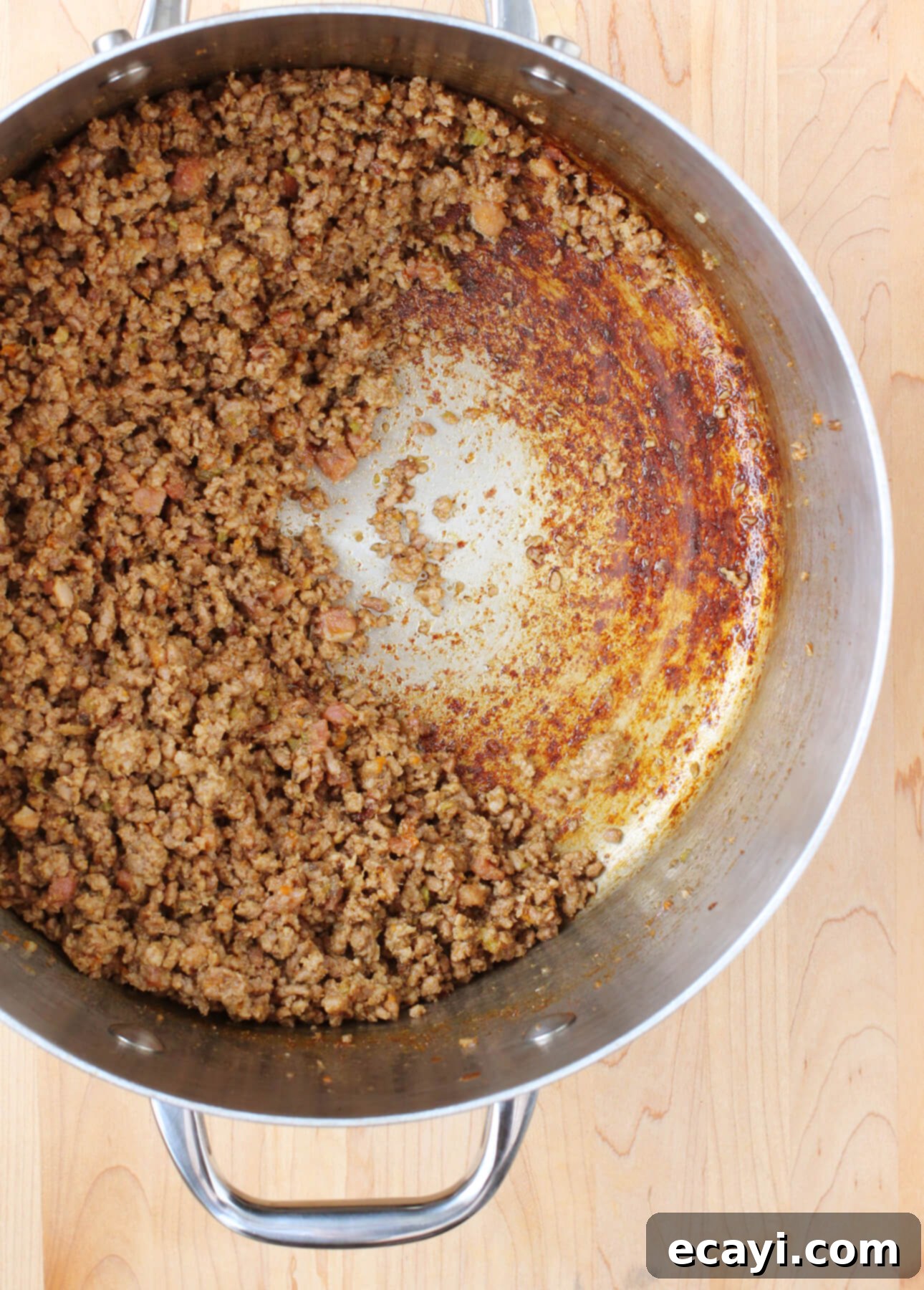
4. Pour the white wine into the pot. Immediately, with your wooden spoon, vigorously scrape up all the delicious brown bits (fond) stuck to the bottom of the pot. Ensure you dislodge every bit, stirring the meat around to facilitate this process. By the time you’re finished scraping, the wine should have largely evaporated, which usually takes about 2 to 3 minutes. Be vigilant and lower the heat if necessary to prevent the meat from sticking to the bottom again.
5. Add the milk, diced or crushed tomatoes, beef broth, the remaining salt (½ tsp/2 ml), and a generous grinding of fresh black pepper to the pot. Bring the mixture to a gentle boil, then immediately reduce the heat to the lowest possible setting.
6. Partially cover the pot, leaving a small gap for steam to escape, and allow the sauce to simmer gently for approximately 2 hours. It’s important to set a timer to remind yourself to stir the sauce every 30 minutes to prevent sticking and ensure even cooking. The sauce is ready when it has developed a rich, creamy consistency and a thick texture similar to oatmeal. When you push the sauce to one side of the pot, no excess liquid should separate from the meat. Taste the sauce and adjust the seasoning with additional salt or pepper if needed.
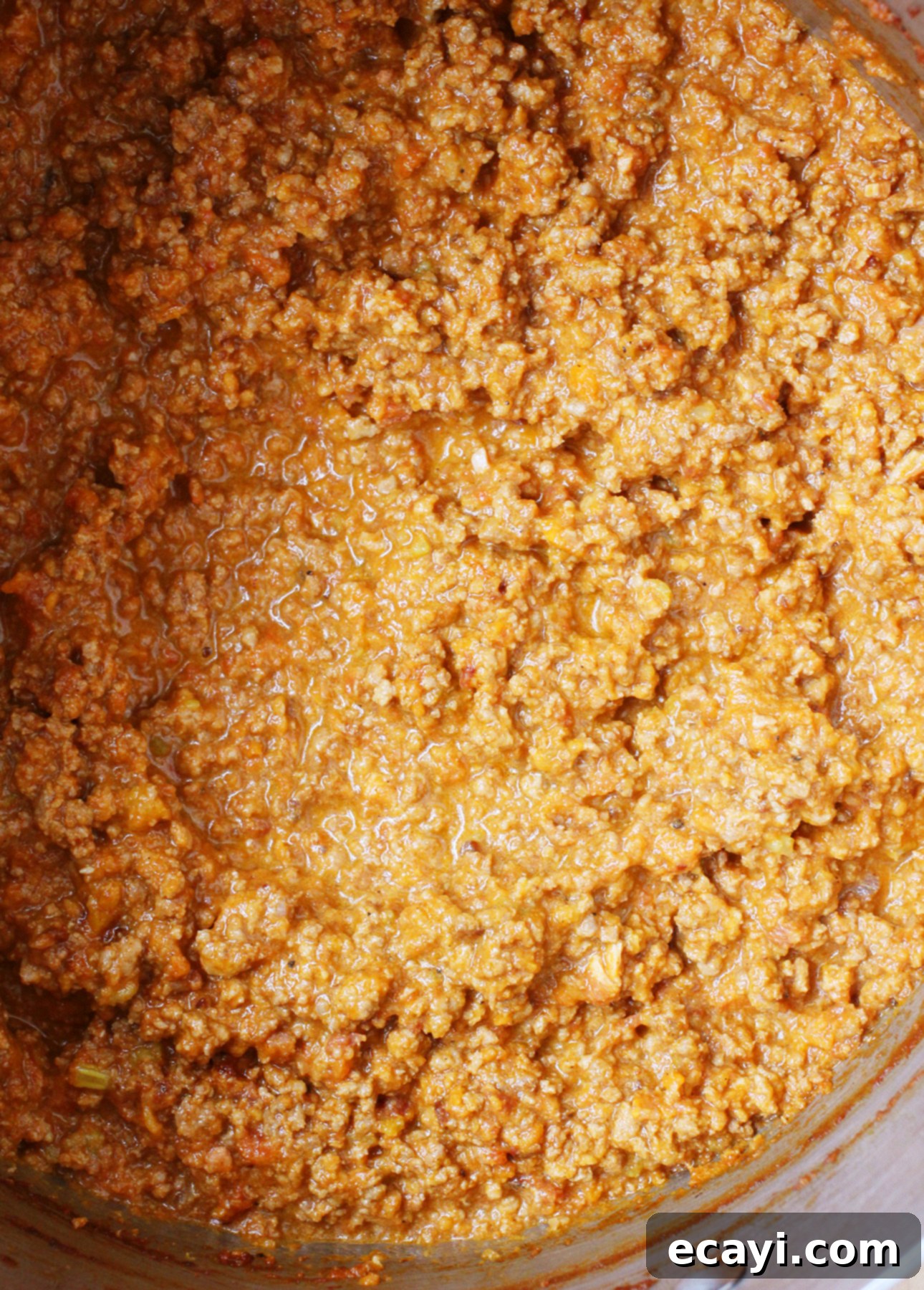
How to Serve Authentic Bolognese Sauce
For a perfect individual portion, aim for a pasta to Bolognese sauce serving ratio of approximately 3 oz (85 g) dry pasta to 1/2 cup (125 ml) of Bolognese sauce. Adjust this ratio proportionally based on the number of people you are serving.
Optimal Serving Method:
1. Begin by warming the Bolognese sauce in a spacious nonstick skillet over medium-low heat.
2. For an incredibly creamy and flavorful boost, add 1 tablespoon (15 ml) of finely grated Parmigiano-Reggiano *per serving* directly into the warm sauce, stirring continuously until the cheese melts and is thoroughly incorporated.
3. Cook your chosen pasta in generously salted boiling water for exactly one minute less than the package’s recommended cooking time. This ensures the pasta is perfectly al dente.
4. Using kitchen tongs, deftly transfer the hot, slightly undercooked pasta directly from the pot into the skillet with the warmed sauce.
5. Crucially, do NOT discard the pasta cooking water! Add 2 tablespoons (30 ml) of this starchy pasta cooking water *per serving* to the skillet.
6. Bring the mixture to a gentle simmer and, using a spatula or tongs, continuously stir and toss the pasta with the sauce. This action allows the pasta to finish cooking, absorb the sauce’s rich flavors, and become beautifully coated and emulsified.
7. Divide the perfectly coated pasta and sauce among warm serving bowls.
8. Garnish with fresh basil leaves, if desired, and a final, generous sprinkle of freshly grated Parmigiano-Reggiano, to taste.
For a detailed visual demonstration of this serving technique, be sure to watch my Bolognese recipe video. It will show you precisely how to present this dish to truly impress your family and friends!
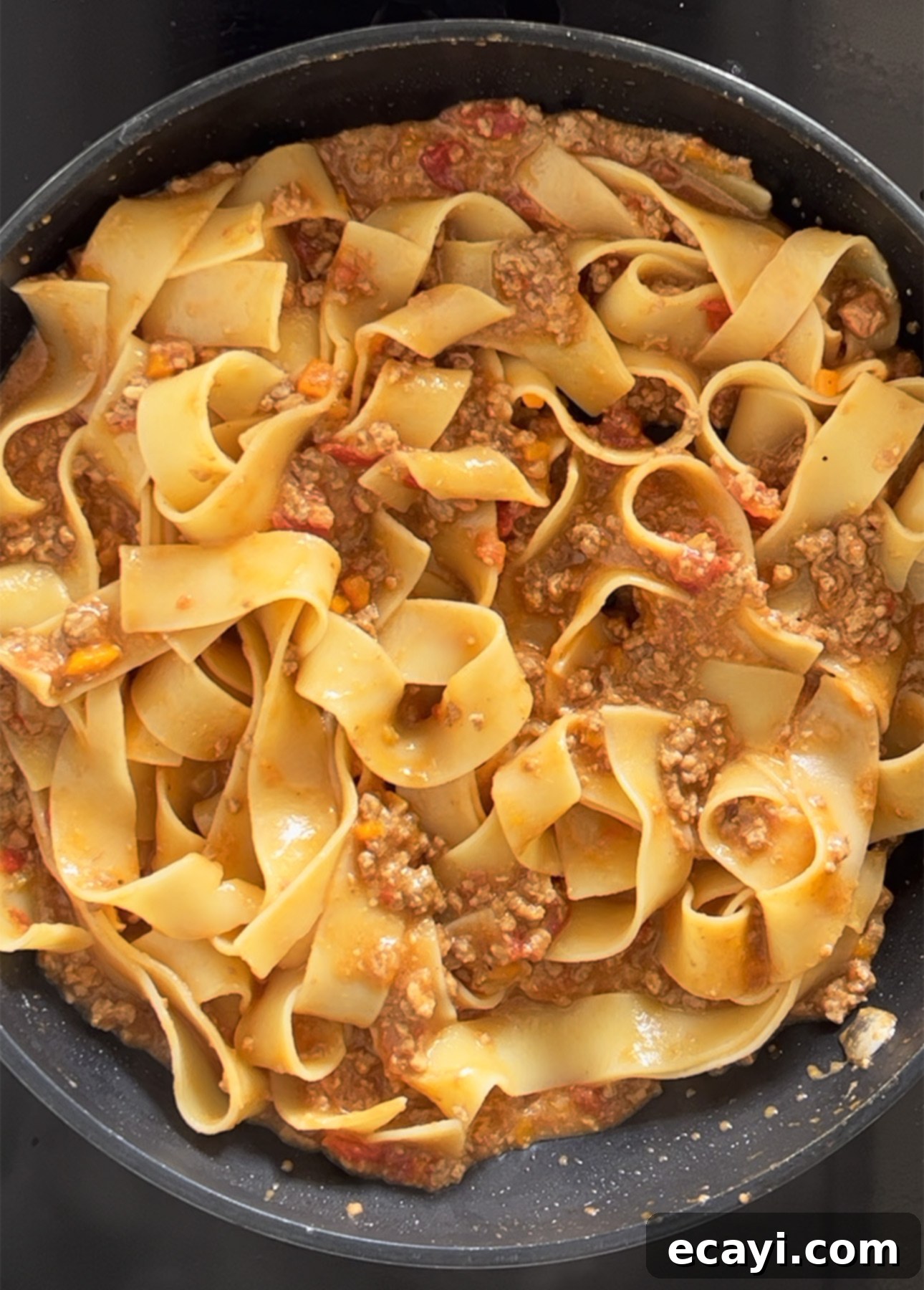
How to Store Bolognese Sauce for Future Enjoyment
Once your delicious Bolognese Sauce has finished cooking, allow it to cool completely to room temperature. To store, divide the sauce into individual portions, remembering that a single serving of Bolognese sauce is typically 1/2 cup (125 ml). Transfer these portions into airtight containers or glass jars. The sauce can be safely refrigerated for up to one week, or frozen for an extended period of up to six months, allowing you to enjoy this authentic Italian classic at your convenience.
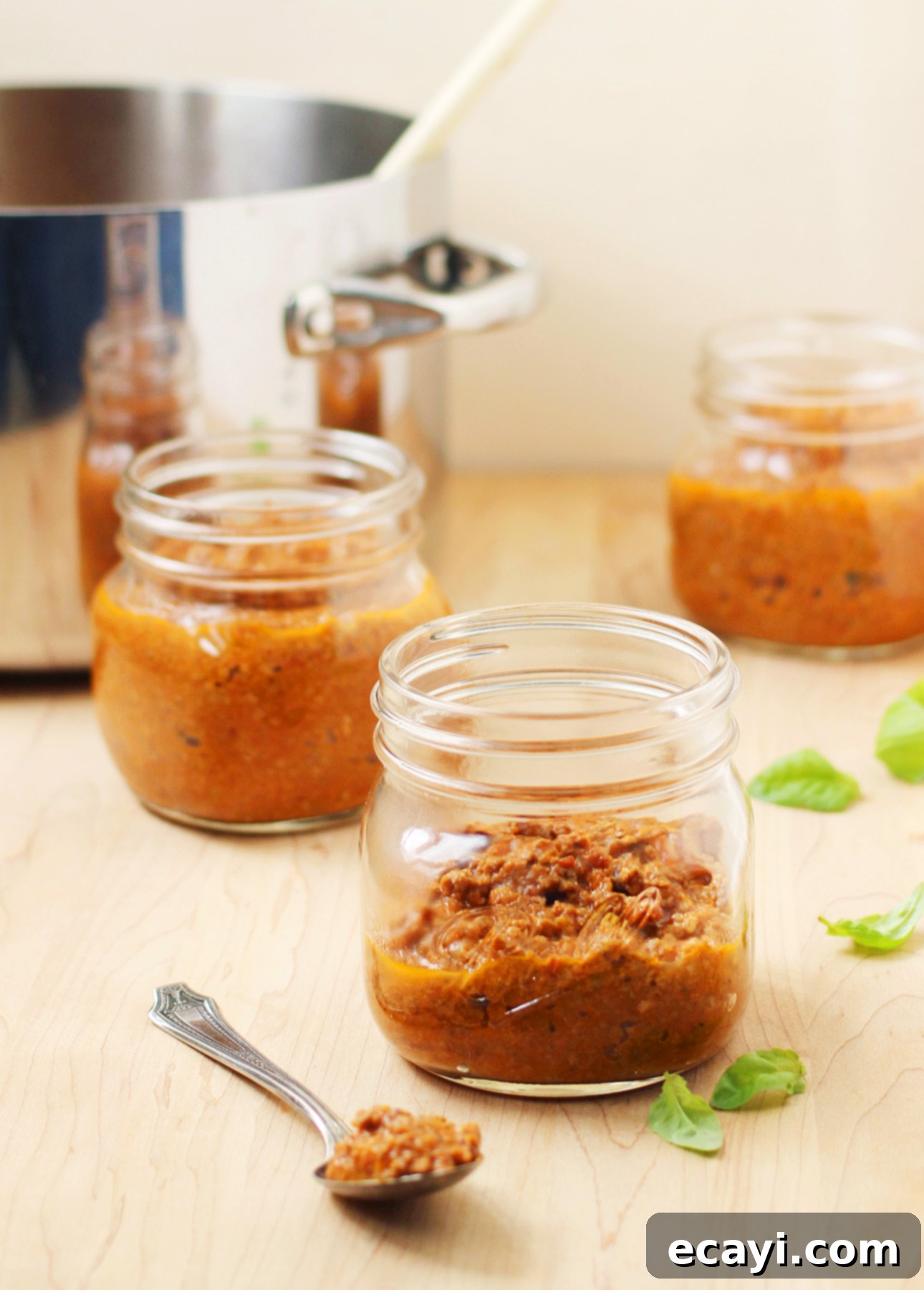
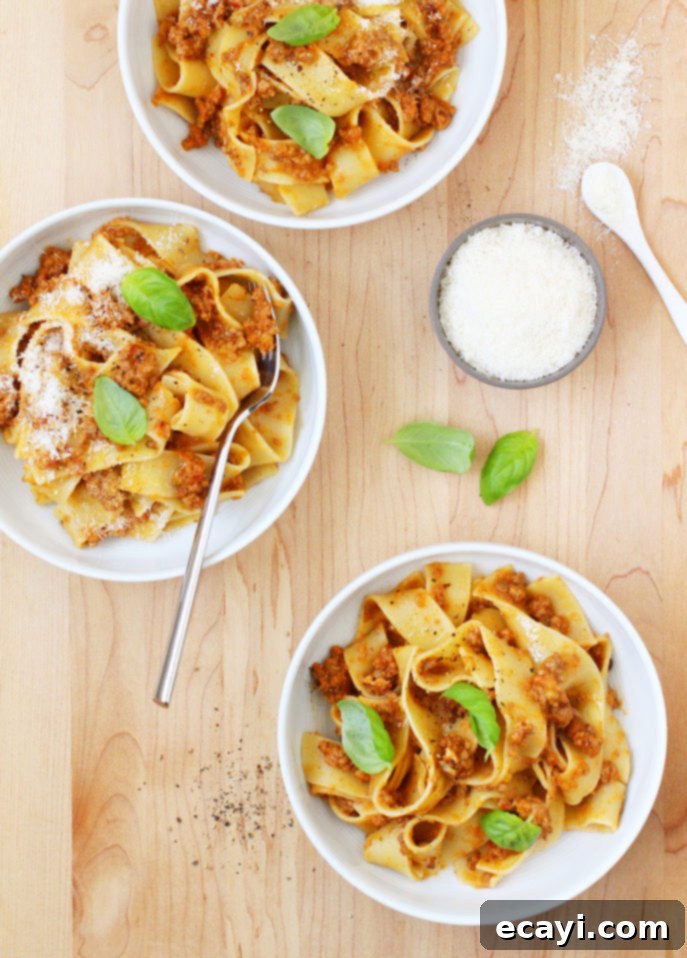
Pin Recipe
RECIPE: Authentic Bolognese Sauce
Ingredients
- 2 tbsp extra-virgin olive oil
- ¼ cup butter
- 1 medium-sized yellow onion, diced
- 4 small or 2 large, carrots, peeled and diced
- 2 celery stalks, diced
- 4 garlic cloves, minced
- 4.5 oz diced pancetta (about 1 cup)
- 1 tsp kosher salt, or fine sea salt
- Freshly ground black pepper
- 2 lb lean ground meat (beef, veal, or a combination)
- 1 cup crisp, dry white wine (such as Pinot Grigio)
- 2 cups whole milk (3.25% m.f.) or partly skimmed milk (2% m.f.)
- 1 can (28 oz/794 g) diced tomatoes, or crushed tomatoes
- 1 cup beef stock
To serve
- Freshly grated Parmigiano-Reggiano
- Dry pappardelle, tagliatelle, linguine, or spaghetti
- Fresh basil (optional)
Instructions
-
In a large stainless steel pot set over medium heat, add the butter and the oil and stir until the butter is melted. Add the onion, carrot, celery, garlic, and half of the salt (½ tsp/2 ml) and sauté for 5 minutes, stirring often, until the vegetables are soft. Add the diced pancetta and cook for a further 10 minutes, until the pancetta is golden and crisp.
-
Add a third of the ground meat, stirring and breaking lumps with a wooden spoon between each addition. Adding the meat gradually allows the excess water and liquid to evaporate, which is key for the meat to caramelize properly. Once the meat is cooked, add a third more of the meat, stirring and breaking lumps as you go. Repeat with the remaining meat.
-
When the meat is cooked and no lumps remain, set a timer to 10 minutes and keep cooking the meat, stirring from time to time. You want the meat to caramelize and even become crispy in spots. Golden bits of meat will stick to the bottom of the pot, which you will deglaze with white wine later. Watch over the pan at all times as you don’t want the meat to burn.
-
Add the white wine into the saucepan. With the wooden spoon, scrape all the brown bits stuck to the bottom of the pot. Push the meat all around to make sure you scrape it all off. By the time you’re finished, the wine will be evaporated (2 to 3 minutes). Be careful not to let the meat stick to the bottom of the pot again—lower the heat if necessary.
-
Add the milk, tomatoes, beef broth, remaining salt (½ tsp/2 ml) and a generous grinding of black pepper. Bring to a boil and then lower to the lowest heat setting.
-
Half-cover and simmer gently for about 2 hours, setting yourself a timer to give the sauce a stir every 30 minutes. The sauce is ready when it looks rich and creamy, and the texture is thick like oatmeal. No liquid should separate from the sauce when you push the sauce to one side. Taste and adjust the seasoning if needed.
-
HOW TO MAKE BOLOGNESE SAUCE IN A SLOW COOKER
If making the sauce in a slow cooker, you need to decrease the quantity of some of the liquids used in the recipe:
1 cup (250 ml) whole (3.25%) or partly skimmed (2%) milk
1 can (14 oz/398 g) diced tomatoes, or crushed tomatoes
1/2 cup (125 ml) beef broth
You also need to add the following ingredient: 1/4 cup (60 ml) tomato paste. Tomato paste is required in the slow cooker method to help add body to the sauce, which won’t benefit from the same simmering and thickening process as the stovetop method.
All the remaining ingredients stay the same.
Cook the onion, carrot, celery, garlic, pancetta, and ground meat following the instructions provided above. Deglaze the pan using the white wine, as instructed, then transfer the mixture to the bowl of a slow cooker. Stir in the milk, tomatoes, beef broth, tomato paste, and some ground black pepper. (Do not add more salt at this point; wait until the end of the cooking process to taste and adjust seasoning if needed.) Cover and cook on the LOW setting for about 6 hours.
If the sauce still seems soupy and runny after that period of time, keep cooking for about 2 hours, or remove the lid and simmer, uncovered, for about 30 minutes, or until you reach the desired consistency.
If the sauce seems a bit dry, you can stir in a bit of beef broth to make it right. Taste the sauce and adjust seasoning if needed.
-
HOW TO SERVE AUTHENTIC BOLOGNESE SAUCE
The pasta to Bolognese sauce serving ratio for 1 person is about 3 oz (85 g) dry pasta to 1/2 cup (125 ml) Bolognese sauce. Multiply this ratio according to the number of people you’re feeding.
Serving method: Warm the Bolognese sauce in a nonstick skillet. Add 1 tablespoon (15 ml) of finely grated Parmigiano-Reggiano *per serving* straight into the sauce, stirring to melt and incorporate the cheese. This addition will boost the flavor of the sauce and produce an incredibly creamy result.
Cook the pasta of your choice in generously salted water for 1 minute less than the recommended cooking time. Once the pasta is cooked, use kitchen tongs to transfer the pasta straight into the skillet with the sauce. Do not discard the pasta cooking water! Add 2 tbsp (30 ml) of the pasta cooking water *per serving* to the skillet and mix to incorporate. Bring to a simmer and stir, using a spatula, to evenly distribute the sauce and coat the pasta with it.
Divide between warm bowls. Garnish with fresh basil leaves, if desired, and more Parmigiano-Reggiano, to taste.
-
HOW TO STORE AUTHENTIC BOLOGNESE SAUCE
Let the sauce cool completely to room temperature. Divide the Bolognese Sauce into portions—keeping in mind 1 serving of Bolognese sauce is 1/2 cup (125 ml)—and store in airtight containers or glass jars. Refrigerate for up to a week, or freeze for up to 6 months.
Video
Did you make this?
Tell me how you liked it! Leave a comment or take a picture and tag it with @foodnouveau on Instagram.
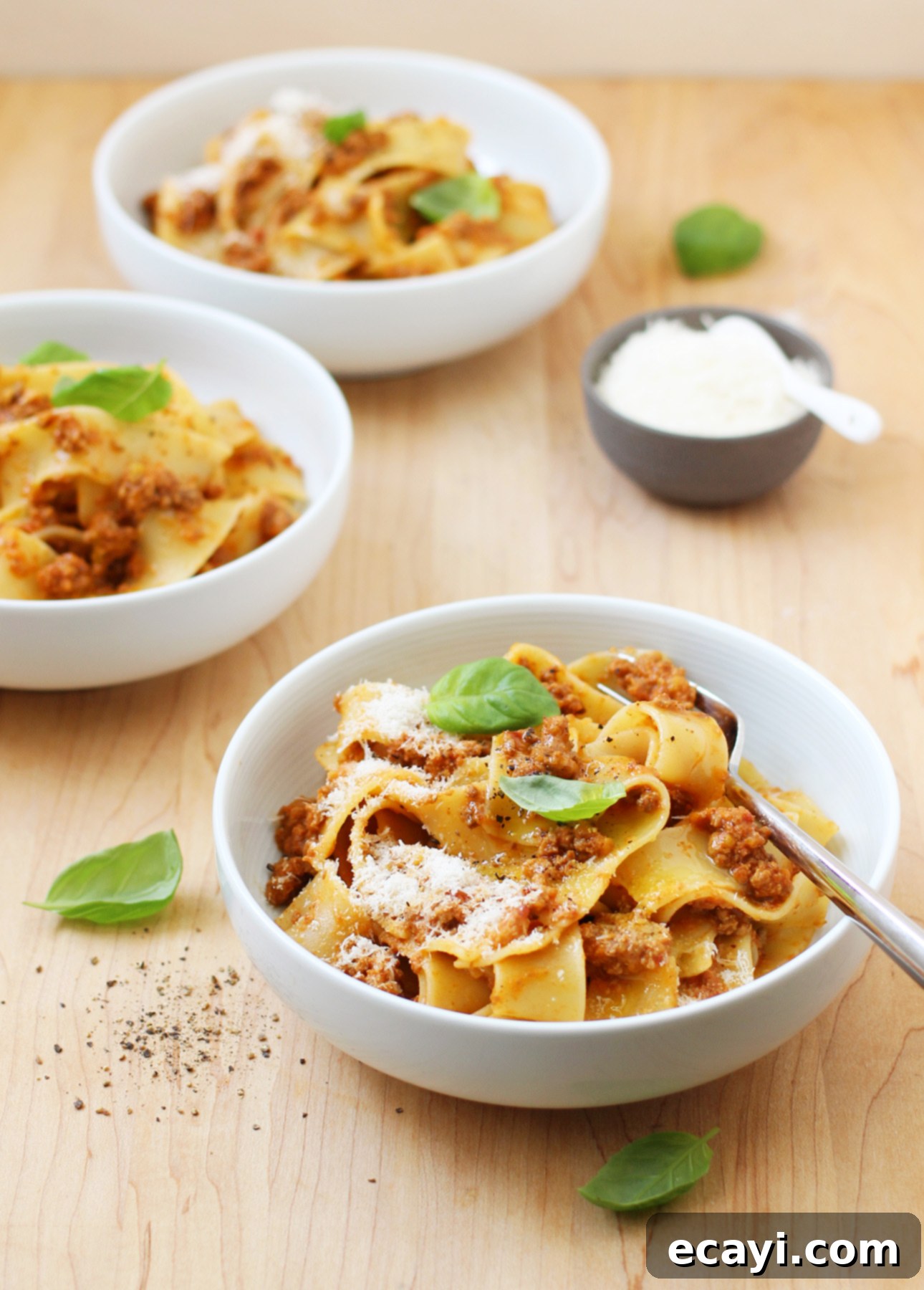
This site is a participant in the Amazon Associates Program, an affiliate advertising program designed to provide a means for the site to earn fees by linking to Amazon and affiliated sites.
If you click on an affiliate link, I may earn advertising or referral fees if you make a purchase through such links, at no extra cost to you. This helps me create new content for the blog–so thank you! Learn more about advertising on this site by reading my Disclosure Policy.
